The Enduring Soak: How Long Do Hot Tubs Last?
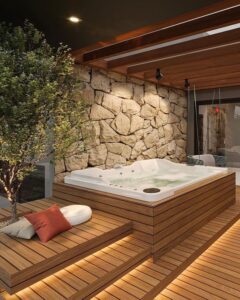
Dive into the comforting embrace of a hot tub and emerge with insights into its lasting journey.
Welcome to the world of hot tub longevity, where the serene pleasure of a quality hot tub meets the practicality of its lifespan. In this realm, the question of “How long do hot tubs last?” is not just a query—it’s a doorway to understanding the intricate dance between enjoyment and care. The life of a hot tub, from its hot tub heaters to the meticulously crafted shell, is a testament to the innovation and dedication behind these oases of relaxation.
Understanding the factors that influence hot tub lifespan is essential for every hot tub owner. A well-maintained hot tub can be the centerpiece of relaxation for years, thanks to diligent care, from monitoring the balance of the water to replacing hot tub heater elements when necessary. However, a poorly balanced hot tub or negligence in maintaining the hot tub pump can drastically shorten its lifespan. Recognizing the importance of these elements is the first step in ensuring your hot tub lasts, providing endless hours of tranquility and comfort.
Unraveling the Lifespan Mystery
Exploring the lifespan of a hot tub uncovers the factors that contribute to its longevity and performance. This section delves into defining the lifespan of hot tubs and the average duration for which you can expect your spa to provide relaxation and comfort.
Defining Hot Tub Lifespan
Understanding the lifespan of a hot tub begins with recognizing what “lifespan” means in this context. It refers to the period during which the hot tub operates efficiently without requiring extensive repairs or replacements of major components. This efficiency is closely tied to the hot tub’s insulation system and the durability of essential parts like hot tub pumps and jets.
A well-maintained hot tub, with regular care and attention to its critical components, can significantly outlast one that’s neglected.
What Is The Average Lifespan Of A Hot Tub?
Several factors, including the quality of its construction, the regularity of maintenance, and the environment in which it is located, influence the average lifespan of a hot tub. Most hot tub pumps, which are vital for circulating water and operating hot tub jets, play a crucial role in this.
With proper care, including the use of hot tub covers to protect against environmental damage, a long hot tub life can be expected. On average, a well-maintained hot tub can last anywhere from 5 to 20 years, depending on these factors and the quality of hot tub pillows and other accessories.
The Heat Factor
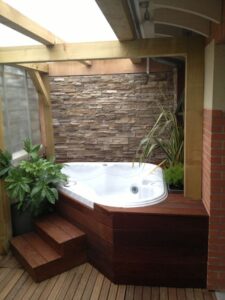
The temperature of your hot tub plays a critical role in both its performance and longevity, directly influencing the efficiency of the hot tub jet and the overall satisfaction of each user relative to their unique preferences. Finding the right heat setting is essential for maximizing the lifespan of your spa, ensuring that both the key components, like the hot tub jet, operate smoothly and that the experience is tailored to the ideal comfort level of each hot tub relative.
Temperature’s Role in Hot Tub Longevity
The temperature at which hot tubs typically operate is not just about comfort; it also impacts how long hot tubs last. High temperatures can accelerate the wear and tear on hot tub parts, potentially leading to a shorter lifespan for your spa.
Conversely, consistently keeping your hot tub at a lower, more moderate temperature can help preserve its components, extending the hot tub’s life. It’s a delicate balance that requires attention to detail to ensure the longevity of your investment.
Finding the Optimal Temperature Balance
To extend the lifespan of a hot tub, consider these recommendations:
- Avoid overheating the spa; stick to the recommended temperature range.
- Lower the temperature when the hot tub is not in use to save energy and reduce wear on the system.
- Use a high-quality hot tub cover to maintain temperature and reduce heating demands.
- Regularly check and maintain the hot tub’s insulation system to ensure efficient heat retention.
Core Components and Their Lifespan
Understanding which components of your hot tub are most susceptible to wear and tear can help you maintain its condition over time. Properly caring for these parts can significantly extend the overall lifespan of your spa.
Which Hot Tub Parts Typically Wear Out First?
The parts with a relatively short life expectancy due to wear and tear include:
- Hot tub pumps, which circulate water and are crucial for operation.
- Hot tub heaters are responsible for maintaining the water’s temperature.
- Hot tub jets, which can become clogged or damaged over time.
- Lower-quality components often fail sooner, leading to higher repair costs and potentially further water balance issues.
The Impact of Water Chemistry
Water chemistry plays a pivotal role in the lifespan of a hot tub. Poorly balanced water, whether too acidic or with cloudy or foamy water, can corrode hot tub parts or lead to scale buildup, affecting the hot tub’s functionality and aesthetics. Properly maintained water chemistry, with the regular addition of balancing chemicals, can prevent these issues, safeguarding the hot tub’s key components from premature breakdown. This care ensures that your new hot tub, or even just a couple of years old spa, maintains the average lifespan that hot tub owners expect, avoiding unnecessary complications and expenses.
4 Easy Steps to Make Your Hot Tub Last Longer

To keep your hot tub in top condition and extend its lifespan, consider these simple maintenance steps:
- Routine Cleaning: Regularly clean the hot tub’s interior and exterior, focusing on areas prone to dirt accumulation.
- Maintain Water Balance: Keep the water chemistry balanced, paying close attention to pH levels, high calcium hardness, and ensuring consistently high sanitizer levels. Unbalanced water can lead to damage to structural components and a need for early replacement.
- Inspect and Replace Components: Check components typically subject to wear and tear, such as filters and seal breaks. Replace them with higher-quality components when necessary to ensure longevity.
- Regular Professional Check-ups: Even with diligent personal care, having a professional inspect your hot tub can help catch issues you might miss. This step is crucial in maintaining the structural integrity of the spa and ensuring that key components are functioning correctly.
Environmental Impacts on Hot Tub Longevity
The environment surrounding your hot tub plays a significant role in determining how long it will last. Let’s explore how external conditions can affect your spa and ways to mitigate these effects.
External Conditions and Hot Tub Durability
Weather and environmental conditions greatly affect the longevity of hot tubs. Extreme temperatures can compromise the outer cabinet, often equipped with a plastic backing, leading to increased repair costs over time. Key factors such as exposure to sunlight, rain, and snow can accelerate wear on the hot tub’s structure. Regular maintenance, including a deep clean of the hot tub’s exterior and checking for minor leaks, can mitigate some of these environmental impacts.
Protecting Your Hot Tub from the Elements
To safeguard your hot tub against environmental damage, consider implementing these protective measures:
Use a High-Quality Cover: This shields the hot tub from harmful UV rays, rain, and debris, while also helping to maintain water balance.
Maintain the Water Balance: Regularly test the basic water chemistry to protect the interior components from corrosion or scale buildup.
Position Strategically: If possible, place your hot tub in a location that minimizes exposure to harsh weather conditions.
Perform Regular Inspections: Check the hot tub’s outer cabinet and plastic backing for signs of wear or damage, addressing issues promptly to prevent further deterioration.
Material Matters
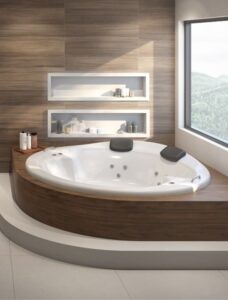
The materials used in the construction of your hot tub significantly influence its longevity. Let’s delve into how these materials can affect the lifespan of your spa.
Comparing Hot Tub Construction Materials
Different materials offer varying levels of durability and resistance to elements such as UV rays and chemicals. For example, hot tubs made with quality parts and high-grade acrylic have a longer lifespan than those constructed with cheaper materials.
The presence of foamy water can indicate a reaction between the water’s chemicals and the hot tub’s materials, potentially leading to a drastically reduced lifespan. Regular cleaning and proper care of these various components can mitigate some negative effects, ensuring a longer service life.
Selecting Materials for Longevity
When choosing a hot tub, prioritize models made from materials known for durability. Look for hot tubs that boast quality parts, which might require a bit more investment initially but have a shorter life expectancy overall. Additionally, the maintenance required for different materials can vary, so selecting a hot tub that aligns with your ability to perform regular maintenance will ensure its longevity. Professional tests can also help determine the best material for your needs, balancing cost with lifespan.
The Usage Equation
How frequently and how you use your hot tub can also impact how long it lasts. Exploring the usage patterns can help you maximize the lifespan of your hot tub.
The Effect of Frequent Use on Lifespan
Regular use of a hot tub puts wear and tear on its components, from the jets to the heating system. Without proper care, this can lead to various components wearing out faster, and the lifespan of the hot tub can be drastically reduced. However, with regular maintenance and careful monitoring of water chemistry, the negative impacts of frequent use can be significantly mitigated.
Balancing Enjoyment and Preservation
Enjoying your hot tub does not have to come at the expense of its longevity. Strategies such as regular cleaning, maintaining water balance, and avoiding overloading the capacity can help preserve your hot tub’s condition. Implementing a schedule for professional tests and maintenance can further ensure that your hot tub remains a source of relaxation and enjoyment for years to come. Ultimately, proper care and attention to how the hot tub is used will ensure its continued performance and enjoyment.
Upgrade or Replace?
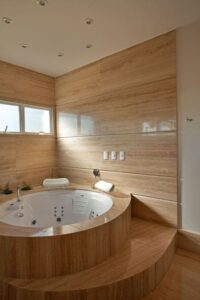
Making the decision between upgrading parts of your hot tub and replacing the entire unit is crucial for maximizing both enjoyment and investment. This section will guide you through making informed choices about upgrading components versus recognizing when it’s time for a new hot tub.
Upgrading Hot Tub Components
Upgrading important components of your hot tub can significantly extend its lifespan and improve its performance. Deciding when and what to upgrade usually depends on the condition of easily replaced parts versus more integral systems. For instance, if the hot tub’s heater or pump begins to fail, replacing these with higher-quality components makes much more sense financially and functionally. This approach ensures your hot tub remains a quality hot tub capable of providing relaxation without the constant need for repairs.
Recognizing the Time for a New Hot Tub
Signs that it’s time to replace your hot tub include persistent issues like cloudy or foamy water that can’t be resolved with regular maintenance or structural damage to the tub itself. Additionally, if the water becomes consistently acidic, causing damage to the hot tub’s internal systems, it might be more cost-effective to invest in a new, quality hot tub.
- Persistent Water Problems: If you’re constantly battling cloudy, foamy, or acidic water despite regular maintenance and chemical treatments, it might be time for a new hot tub. Persistent water issues can indicate failing components or systemic problems that are difficult to fix permanently.
- Frequent Repairs: When your hot tub requires frequent repairs, especially to its important components like the heater, pump, or jets, the repair costs can quickly add up. If these repairs become more frequent and costly, investing in a new hot tub might be more economical.
- Visible Wear and Tear: Significant signs of wear and tear, such as cracks in the shell, leaks that are hard to fix, or deteriorating insulation, can compromise the hot tub’s efficiency and safety. These structural issues often merit the purchase of a new unit.
- Energy Inefficiency: Older hot tubs can be energy hogs, leading to high electricity bills. If you notice a significant increase in energy consumption without a corresponding increase in usage, your hot tub’s efficiency might be compromised. A new, energy-efficient model could reduce your long-term costs.
In Summary
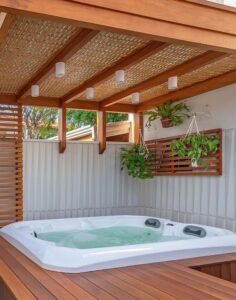
Two key factors greatly affect the longevity of a hot tub: the quality of its build and the diligence of its maintenance. A hot tub built with durability in mind, combined with a comprehensive approach to upkeep—such as adding balancing chemicals and addressing repairs promptly—ensures that key components break down less frequently, extending the spa’s lifespan.
Regular maintenance makes much sense financially, as it can prevent issues that lead to a drastically reduced lifespan and high repair costs. Ultimately, the right hot tub will last a significant amount of time, bit depending on the owner’s commitment to its care.
For personalized advice on selecting and maintaining a hot tub that suits your needs, consult with Foley Walk-in Showers & Tub Installers. Remember, the longevity of your spa is directly tied to how well you maintain it; let’s ensure it provides years of enjoyment.
